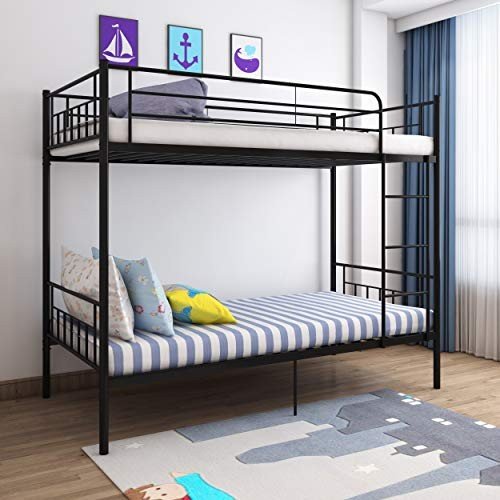5 Clarifications Regarding Kids Bunk Bed
The Ultimate Guide to Kids Bunk Beds: Maximizing Space and Fun
With the increase of vertical living and smaller spaces, the popularity of bunk beds has soared among families. Bunk beds not only offer a practical sleeping option, particularly in shared rooms, however they likewise bring a component of enjoyable into a kid's life. This detailed guide looks into the features, benefits, and considerations of kids' bunk beds, making it much easier for moms and dads to pick the best bed for their little ones.
Features of Kids Bunk Beds
Bunk beds are flexible furniture pieces that serve more than a single purpose. Here are some crucial features to consider:
Feature
Description
Product
Bunk beds can be constructed from wood, metal, or a mix of both, using varying levels of durability and design alternatives.
Safety Features
Many bunk beds come geared up with guardrails, secure ladders, and capped supports for security, especially important for young kids.
Design Variety
Choices vary from classic designs to modern designs, guaranteeing a match for any room décor.
Space-Efficiency
Bunk beds make use of vertical space, making them perfect for smaller sized rooms.
Convertible Options
Some models can be converted into 2 separate beds, supplying flexibility as kids grow.
Storage Solutions
Some bunk beds feature built-in storage drawers or racks, helping to keep the room arranged.
Advantages of Kids Bunk Beds
Purchasing a bunk bed includes several advantages:
- Space Saving: Bunk beds make the most of floor space, enabling more play area or storage solutions.
- Fun Factor: With a bunk bed, kids belong that cultivates imagination and companionship throughout pajama parties or playdates.
- Affordable: Instead of acquiring 2 different beds, a bunk bed can accommodate two children at as soon as, saving cash in the long run.
- Flexibility: Many bunk beds can be dismantled or transformed into twin beds, making them a long-lasting financial investment as children's requirements alter.
- Social Interaction: Bunk beds motivate household bonding and friendships, offering an inviting space for kids to share stories and laughter.
Considerations When Choosing a Kids Bunk Bed
When choosing the ideal bunk bed for a kid, moms and dads must take into consideration different elements:
- Safety Standards: Ensure that the bunk bed complies with safety policies and features important safety features.
- Age Appropriateness: Different models deal with various age groups. For instance, traditional bunk beds may not be ideal for younger children.
- Space Dimensions: Measure the bedroom to guarantee the bunk bed fits properly, permitting space to walk around conveniently.
- Weight Capacity: Consider the weight load of each bed and ensure it accommodates the child's weight easily.
- Style Preferences: Letting children participate in the choice procedure can help them feel more fired up about their new bed.
Types of Kids Bunk Beds
Bunk beds can be found in different designs and configurations to fit numerous needs:
Type
Description
Standard Bunk Bed
A traditional design with one bed stacked on top of another, generally utilizing a ladder to access the leading bunk.
L-Shaped Bunk Bed
Features two bunk beds linked in an L-shape, often more roomy and suitable for kids sharing a space however needing a bit more space.
Triple Bunk Bed
Makes up three stacked beds, suitable for maximizing sleeping plans in really limited areas.
Loft Bed
A raised bed with space underneath that can function as a play location, study corner, or additional storage.
Futon Bunk Bed
Combines a bunk bed on the top with a futon or couch beneath, making it great for slumber parties and taking full advantage of space usage.
Convertible Bunk Bed
Can be separated into 2 private beds, using versatility as kids's needs change.
Taking Care Of Kids Bunk Beds
Maintaining bunk beds is essential for ensuring longevity and safety. Here are some simple care practices:
- Regular Inspections: Check the bed routinely for loose screws and tightened bolts to ensure stability.
- Tidiness: Keep bed linen clean and fresh, turning mattresses for even use.
- Guardrails: Ensure guardrails are safe and in place, especially if kids tend to move around a lot in their sleep.
- Air Circulation: Ensure the bed has sufficient air flow, preventing moisture accumulation that can result in mold or mildew.
FAQs About Kids Bunk Beds
Q1: At what age can a kid securely utilize a bunk bed?
A1: Generally, kids aged six and older are considered safe to use the upper bunk due to the height and stability elements involved.
Q2: Can I place a bunk bed near a window?
A2: It is advisable to prevent putting a bunk bed near windows to lower the risk of falling or injuries.
Q3: Are bunk beds safe for younger kids?
A3: While some contemporary bunk beds come with safety functions accommodating more youthful children, it is generally advised to wait until they are older, usually over six years.
Q4: What is the common weight limitation for top bunks?
A4: Weight limits vary by design however normally range from 150 to 250 pounds. Constantly refer to the maker's requirements.
Q5: How often should I check the bunk bed's safety features?
A5: It is advisable to carry out a security check every couple of months or whenever you notice any signs of wear.
Kids' bunk beds work as a strategic service for families aiming to maximize space while offering an enjoyable and engaging sleeping environment for their kids. With a variety of alternatives offered— from basic designs to loft beds— parents have the liberty to select something that fulfills their family's specific needs. By considering Helaine Herke as security, space viability, and their children's preferences, parents can make an informed option, ensuring that each kid is excited about bedtime while gaining from a well-organized room.
